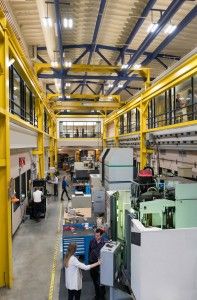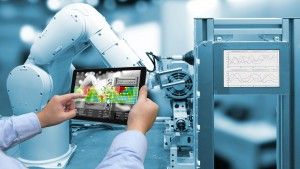The Potential Role of IIoT in the Job Shop
For the discussion on potential emerging technologies in gear manufacturing, Kampka provided the following detailed example:
A job shopper bids on a job and gets the purchase order. The job shopper gets a detailed drawing if they didn’t have it prior to bidding. This drawing will be the single source of truth. In an Industry 4.0/IIoT scenario, the job shopper will derive a data set in universal file format from the drawing or in the future simply get that data set directly from the customer. This data set will include all necessary workpiece data for the machine tools and gear measuring machines.
For this simplified case, the manufacturing chain just consists of hobbing, heat treatment, gear grinding and final measuring. The job shopper manufactures the blank and marks it with a unique identifier. Via this marking the part will be linked to the information from the data set saved in a centralized server or cloud, acting as the single source of truth. As long as the machine tools are not connected to this source, the workers may have an external device (e.g. tablet) linked to the source (e.g. via Wi-Fi). By scanning the part, the worker will know which tool to use and have all the data to program the machine tool.
At the same time, a manufacturing simulation will run and give a proposal for process parameters of the given workpiece tool combination. During machining a wear model will predict tool wear and optimize shifting. All this information will be saved and linked to the tool marked by a unique identifier itself. That way, the next time the same tool is used on whatever machine in the shop floor all that information can be taken into consideration.
“For example, if the next batch size is the last one for the given tool for a while and the job shopper knows that the tool needs to be reconditioned after the batch anyhow, the software may propose more progressive process parameters to max out the tool. On the other hand, if the job shopper needs to manufacture more parts than expected, than the software might suggest less aggressive process parameters to make that work as well,” Kampka said.
But those software modules and sophisticated models need to be developed, which is quite challenging and time consuming. This can’t be done by the job shopper itself but needs to be provided by an external source capable of simulating the manufacturing process and predicting the resulting running behavior.
“This is one example where the universities come into play, which have the capabilities of creating those models. An approach to this is described in a technical article by WZL that will appear in an upcoming issue of Gear Technology focusing on the virtual process chain. A comprehensive solution is not available on the market yet,” Kampka said.
Going on to gear grinding, the focus might change to maximize productivity without causing grinding burn. This might result in adaptive processes where the parameters will be controlled by knowing the amount of coolant reaching the actual cutting zone and thereby change along the workpiece width. Other possibilities are spindle power monitoring to control the axial feed or even machine tools learning from previous cuts and use those to adjust the infeed and the positioning for the roughing cuts.
“All of these approaches rely heavily on mathematical models running in the background which are called digital shadows for lower complexity in real time applications and digital twins for even higher complexities which don’t require real time computing,” Kampka said.








